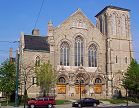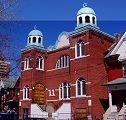St. Basil’s Roman Catholic Church
Located on St. Joseph Street west of Bay, St. Basil’s Church and St. Michael’s College were designed by architect William Hay, and were built in 1855-56. Hay’s other designs included the Yorkville Town Hall, since demolished. The historical plaque reads as follows: “St. Michael’s College. In 1852 this college was established as a Roman Catholic boys’ school in the palace of the right Reverend Armand, Comte de Charbonnel, Bishop ofToronto and a vigorous opponent of the public school system in Canada West. The minor seminary opened by Basilian priests that year was combined with the school in 1853, and in 1855 St. Michael’s College was incorporated. A new collegiate structure and adjoining parish church, St. Basil’s were built here on Clover Hill. On September 15, 1856, classes commenced with the Reverend Jean Mathieu Soulerin, C.S.B., as superior. The college progressed gradually and in 1881 it affiliated with the University of Toronto. St. Michael’s formally became an arts college within the University in 1910.”
Knox Presbyterian Church is the oldest Presbyterian congregation in Toronto, dating from 1820. The original Knox Church was located on property donated by Jesse Ketchum, bounded by Queen, Bay, Richmond and Yonge Streets. Ketchum came to Toronto from New York in 1799 and operated a very successful tannery at Yonge and Adelaide Streets. He was known as an outstanding philanthropist, giving land not only for Knox Church, but for a schoolhouse and Temperance Hall in Yorkville. He was a reform member of parliament for many years. He retired to Buffalo in 1845 and continued his philanthropic work there, dying in 1867. The first Knox Church on the site, which had its entrance on Richmond Street, burned in 1847. A new and larger church, designed by architect William Thomas, was built in 1847-8, this time with the entrance facing Queen Street. In 1881 Robert Simpson’s department store opened on Queen Street just east of the church and west of Yonge. A fire in 1895 at Simpson’s spread to Knox and destroyed its tower and steeple. The tower and steeple were not rebuilt; before long Knox decided to move to its current location on Spadina Avenue south of Harbord. The present church dates from 1909 and was designed by architect James Wilson Grey, in a combination of Romanesque and Gothic Revival styles. Its seating capacity is 1000. Knox’s land on Queen St. was sold to Simpson’s, who expanded to fill the entire Queen/Yonge/Richmod/Bay parcel of land. Their building remains today, operated by the Hudson’s Bay Co.
Kiever Synagogue, Kensington Market
Located at the corner of Denison Square and Bellvue Avenue, on the spot where the pioneering Denison family’s grand manor Belle Vue once stood, this synagogue was built by the First Russian Congregation Rodfie Sholom Anshei Kiev. (“Pursuers of Peace, Men of Kiev”) The congregation was established in 1913 by Ukrainian Jews who had come to Canada to escape persecution in Czarist Russia. Architect B. Swartz designed the building with its middle-eastern flavour and twin Byzantine domes. In the 1920’s and 30’s Toronto’s Jewish inhabitants began to move into the Kensington Market area. Over time there were nearly 30 small synagogues in the area, each used by a different group of Jews from different parts of Europe. In 1979 Kiever Synagogue was declared an historical building under the Ontario Heritage Act, the first Jewish landmark to receive this designation.
St. George Greek Orthodox Church, Bond St.
Located on Bond Street in the Yonge and Dundas area, St. George Greek Orthodox Church was originally Holy Blossom Synagogue. It is the oldest synagogue building still standing in Toronto. Designed by architect John Wilson Siddall and built in 1895, this Byzantine-inspired structure was acquired by the Greek Orthodox parish of St. George in 1937. St. George’s parish is the oldest Greek Orthodox community in Canada, dating from 1909 when the Greek population of Toronto numbered about 200. Prior to 1937 St. George’s was located on Jarvis St. near Shuter. In the 1980’s the building was renovated and beautiful Byzantine frescoes were painted on the walls and ceiling by iconographers from Mt. Athos, Greece.
Holy Blossom Temple traces its roots back to the founding of Toronto’s first synagogue in 1856. It was originally called Toronto Hebrew Congregation (Sons of Israel). The first services were held in rented quarters above Coombe’s Drug Store at Yonge and Richmond Streets. The name “Holy Blossom” came not from the congregation itself, but from a non-member from Montreal named Gottschalk Ascher, who donated the synagogue’s first scroll of the Torah in 1857, together with a silver pointer inscribed “Given to the Holy Congregation ‘Holy Blossoms’ in the city of Toronto”. “Holy Blossom” was not adopted by the congregation until 1871. By the mid-1870’s the number of Jews in Toronto had increased substantially, rendering the rented premises at Yonge and Richmond inadequate. Land was obtained on the south side of Richmond Street east of Victoria, and the prominent architectural firm Stewart and Strickland were employed to design the building. It was dedicated in 1876. By 1890 the congregation had outgrown the Richmond Street building, and a decision was made to build a new synagogue on Bond Street, dedicated in 1897. (now St. George’s Greek Orthodox Church – see above.) Holy Blossom is now located on Bathurst Street south of Eglinton, where it serves a large community of Reform Jews. The present building dates from 1937.



